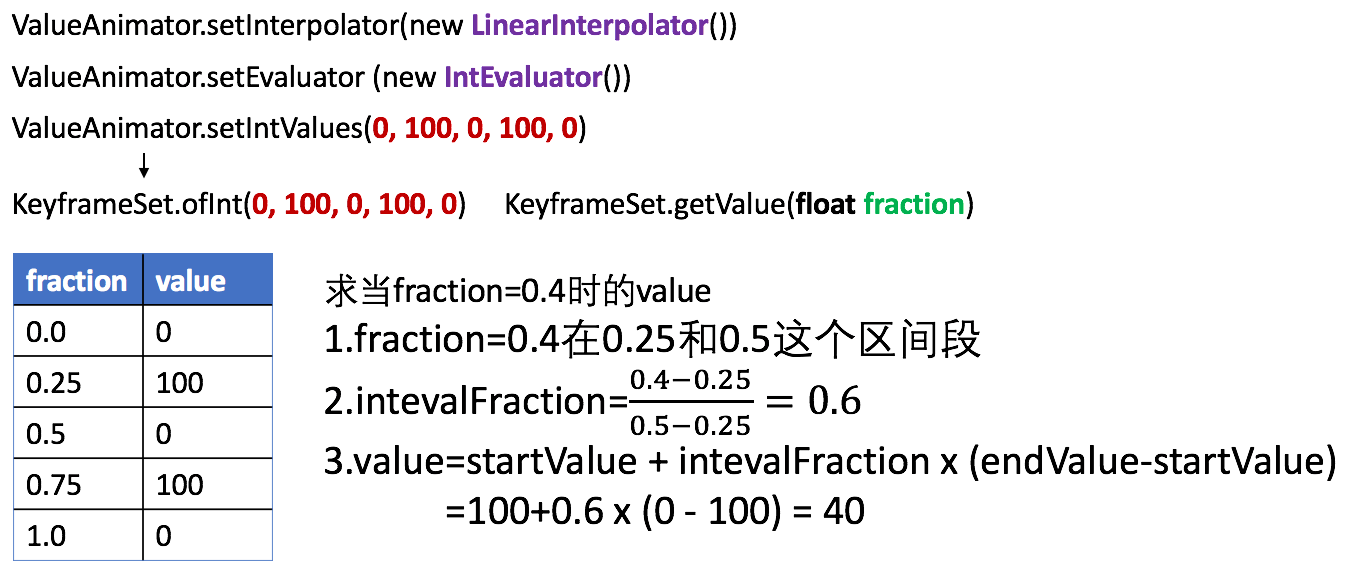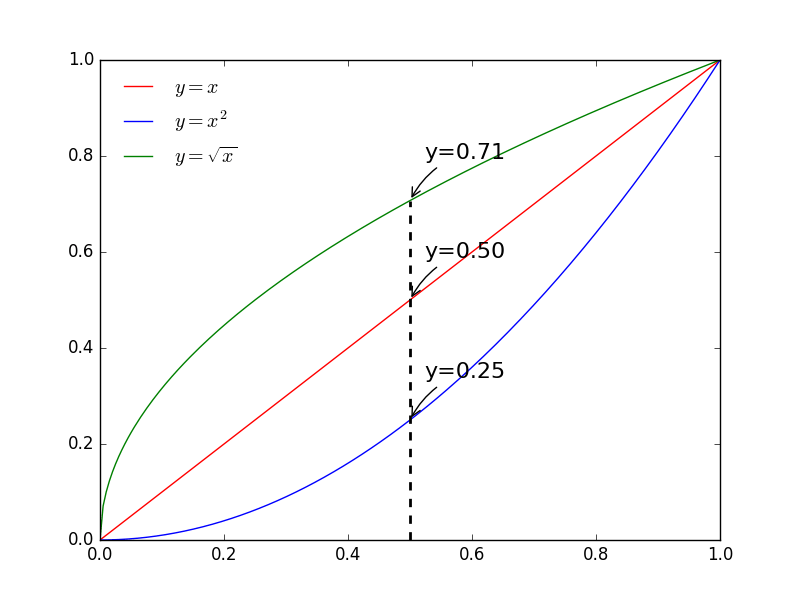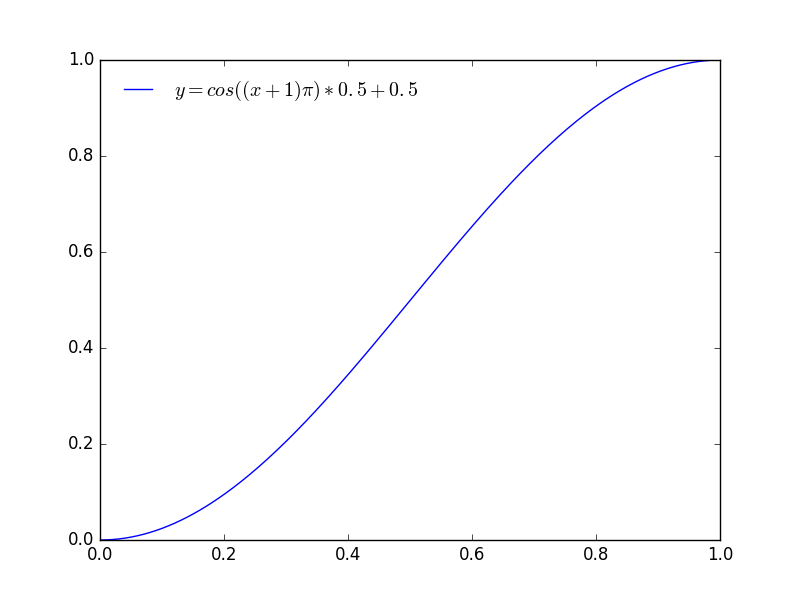当数学遇上动画:讲述ValueAnimator、TypeEvaluator和TimeInterpolator之间的恩恩怨怨(1)
其实关于ValueAnimator的内部工作原理大家也都清楚,本文只是选择从数学函数的角度来解析这个原理,方便理解。看完了本节之后我们就更加清楚如何借助TypeEvaluator和TimeInterpolator来帮助我们实现动画等知识。
本系列文章共有三篇,第一篇通过源码解析ValueAnimator类,第二篇通过实例解析TimeInterpolator和TypeEvaluator,第三篇分析常见动画背后的缓动函数,最后引出一个新的Android动画开发的辅助库Yava。
1 Android动画基础知识
(1)狭义而言,动画一般就是指某个View组件的某个或者某些属性值在一段时间内不断变化的过程,这个变化过程往往有个起始值、结束值和一系列的中间值,ValueAnimator就是用来反映这个属性值变化过程的重要类,所以本文的介绍主要是以分析ValueAnimator为主。
(2)如果将属性值的变化过程看做一个数学函数的话,从动画效果上来看它是连续的,但实际上它还是离散的,因为它实际上也就是通过插入中间值(简称插值)从而”一帧一帧”完成动画的,那每一帧在哪里取,取多少呢?这也就是ValueAnimator类主要完成的作用。
那到底ValueAnimator是怎么控制属性值的变化过程的呢?答案是借助TimeInterpolator和TypeEvaluator来帮忙!TimeInterpolator用来控制在哪里取,而TypeEvaluator用来控制取多少。(注:取多少个点进行插值是不确定的,例如动画持续时间1s,可能取60,也可能取54、57或者58个中间点进行插值)
先说本小节结论,每一个ValueAnimator其实就是一个的TimeInterpolator和一个TypeEvaluator的结合体。从数学的角度来看,ValueAnimator就是由TimeInterpolator和TypeEvaluator这两个简单函数组合而成的一个复合函数。用图来表述如下:

你也可以将TimeInterpolator和TypeEvaluator看作是工厂流水线上的两个小员工,那么ValueAnimator就是车间主管啦。TimeInterpolator这个小员工面对的是产品的半成品,他负责控制半成品输出到下一个生产线的速度。而下一个生产线上的小员工TypeEvaluator的任务就是打磨半成品得到成品,最后将成品输出。
2 结合源码解释函数形式
(1)假设TimeInterpolator是函数x=f(t),t表示动画已经完成的时间比率(例如动画的总时长是10s,已经过了4s了,那么t=0.4),所以t的取值范围是[0,1],0表示动画开始,1表示动画结束。该函数的返回值指的是动画实际插值的时间点,一般是0到1之间,但是也可以小于0(“下冲”)或者大于1(“上冲”)。
该函数的作用是把当前时间进度映射成另一个值,这样动画参照的时间由此被”篡改”,动画的速度由此被改变。 (后面还有详细介绍)
参考接口TimeInterpolator的定义:
/**
* A time interpolator defines the rate of change of an animation. This allows animations
* to have non-linear motion, such as acceleration and deceleration.
*/
public interface TimeInterpolator {
/**
* Maps a value representing the elapsed fraction of an animation to a value that represents
* the interpolated fraction. This interpolated value is then multiplied by the change in
* value of an animation to derive the animated value at the current elapsed animation time.
*/
float getInterpolation(float input);
}
(2)假设TypeEvaluator是函数y=g(x,a,b),x就是前面函数f(t)篡改之后的插值的时间点,a、b分别表示属性动画的起始值和结束值。
该函数的作用是通过起始值、结束值以及插值时间点来计算在该时间点的属性值应该是多少。
参考接口TypeEvaluator的定义:
/**
* Interface for use with the {@link ValueAnimator#setEvaluator(TypeEvaluator)} function. Evaluators
* allow developers to create animations on arbitrary property types, by allowing them to supply
* custom evaluators for types that are not automatically understood and used by the animation
* system.
*/
public interface TypeEvaluator<T> {
/**
* This function returns the result of linearly interpolating the start and end values, with
* <code>fraction</code> representing the proportion between the start and end values. The
* calculation is a simple parametric calculation: <code>result = x0 + t * (x1 - x0)</code>,
* where <code>x0</code> is <code>startValue</code>, <code>x1</code> is <code>endValue</code>,
* and <code>t</code> is <code>fraction</code>.
*/
public T evaluate(float fraction, T startValue, T endValue);
}
(3)假设TimeInterpolator和TypeEvaluator是上面两个简单函数,那么ValueAnimator也是一个函数,它其实就是表示TimeInterpolator的函数x=f(t)和表示TypeEvaluator的函数y=g(x,a,b)结合而成的复合函数F=g(f(t),a,b)。
参考ValueAnimator中animateValue方法的定义:
/**
* This method is called with the elapsed fraction of the animation during every
* animation frame. This function turns the elapsed fraction into an interpolated fraction
* and then into an animated value (from the evaluator. The function is called mostly during
* animation updates, but it is also called when the <code>end()</code>
* function is called, to set the final value on the property.
*/
void animateValue(float fraction) {
fraction = mInterpolator.getInterpolation(fraction); //TimeInterpolator 函数
mCurrentFraction = fraction;
int numValues = mValues.length;
for (int i = 0; i < numValues; ++i) {
mValues[i].calculateValue(fraction); //TypeEvaluator 函数
}
if (mUpdateListeners != null) { // 通知监听器
int numListeners = mUpdateListeners.size();
for (int i = 0; i < numListeners; ++i) {
mUpdateListeners.get(i).onAnimationUpdate(this);
}
}
}
3 通俗解析各个击破
3.1 关于ValueAnimator
(0)ValueAnimator就是一个的TypeEvaluator和一个TimeInterpolator的结合体,所以该类有两个方法分别用来设置动画的TypeEvaluator和TimeInterpolator。
(1)setInterpolator方法可以不调用,默认是加速减速插值器AccelerateDecelerateInterpolator,但是如果调用且传入的参数为null的话,那么就会被设置成线性插值器LinearInterpolator (暂时不清楚为什么要这样做)。
(2)setEvaluator方法也可以不调用,默认会根据属性值的类型设置一个IntEvaluator或者FloatEvaluator。后面会讲到这类TypeEvaluator可以看作是线性估值器"LinearTypeEvaluator"(并没有这个说法,因故加上引号)。
参考ValueAnimator的部分源码:
//默认的TimeInterpolator是AccelerateDecelerateInterpolator
// The time interpolator to be used if none is set on the animation
private static final TimeInterpolator sDefaultInterpolator = new AccelerateDecelerateInterpolator();
/**
* The time interpolator used in calculating the elapsed fraction of this animation. The
* interpolator determines whether the animation runs with linear or non-linear motion,
* such as acceleration and deceleration. The default value is
* {@link android.view.animation.AccelerateDecelerateInterpolator}
*
* @param value the interpolator to be used by this animation. A value of <code>null</code>
* will result in linear interpolation.
*/
@Override
public void setInterpolator(TimeInterpolator value) {
if (value != null) {
mInterpolator = value;
} else {
// 如果传入的TimeInterpolator是null的话就设置为LinearInterpolator
mInterpolator = new LinearInterpolator();
}
}
/**
* The type evaluator to be used when calculating the animated values of this animation.
* The system will automatically assign a float or int evaluator based on the type
* of <code>startValue</code> and <code>endValue</code> in the constructor. But if these values
* are not one of these primitive types, or if different evaluation is desired (such as is
* necessary with int values that represent colors), a custom evaluator needs to be assigned.
* For example, when running an animation on color values, the {@link ArgbEvaluator}
* should be used to get correct RGB color interpolation.
*
* <p>If this ValueAnimator has only one set of values being animated between, this evaluator
* will be used for that set. If there are several sets of values being animated, which is
* the case if PropertyValuesHolder objects were set on the ValueAnimator, then the evaluator
* is assigned just to the first PropertyValuesHolder object.</p>
*
* @param value the evaluator to be used this animation
*/
public void setEvaluator(TypeEvaluator value) {
if (value != null && mValues != null && mValues.length > 0) {
mValues[0].setEvaluator(value);
}
}
(4)调用ValueAnimator的ofInt方法时发生了什么
ValueAnimator的ofInt方法是创建动画常用的方法,该方法会调用ValueAnimator的setIntValues,其中调用了PropertyValuesHolder的setIntValues方法,里面又调用了KeyframeSet的ofInt方法用来得到动画的帧集合,该方法的实现如下:
//根据提供的数字序列得到动画的核心帧集合
public static KeyframeSet ofInt(int... values) {
int numKeyframes = values.length;//有多少个数字就有多少帧
IntKeyframe keyframes[] = new IntKeyframe[Math.max(numKeyframes,2)];//至少有2帧
if (numKeyframes == 1) {//如果只传入一个数字,那么该数字就是结束帧的值
keyframes[0] = (IntKeyframe) Keyframe.ofInt(0f);
keyframes[1] = (IntKeyframe) Keyframe.ofInt(1f, values[0]);
} else {//如果传入多个数字,那么可以将整个动画时间间隔均分,每个数字按顺序在每个时间比率上占据一个属性值
keyframes[0] = (IntKeyframe) Keyframe.ofInt(0f, values[0]);
for (int i = 1; i < numKeyframes; ++i) {
keyframes[i] = (IntKeyframe) Keyframe.ofInt((float) i / (numKeyframes - 1), values[i]);
}
}
return new IntKeyframeSet(keyframes);
}
Keyframe的ofInt方法的签名为Keyframe ofInt(float fraction, int value):前者就是动画已经完成的时间比率,后者是该帧的属性值,它表示在这个特定的时间比率对应的时刻,函数曲线会经过或者非常接近这个属性值(可能是没有经过,而只是很接近很接近,毕竟是曲线拟合嘛)。
上面得到的帧只是动画的几个核心帧,肯定不是动画的全部帧,那中间的其他帧是怎么计算的呢?
这个问题我们可以看下KeyframeSet的getValue方法,方法传入的参数就是动画的时间比率,返回值就是此帧的属性值。
/**
* Gets the animated value, given the elapsed fraction of the animation (interpolated by the
* animation's interpolator) and the evaluator used to calculate in-between values. This
* function maps the input fraction to the appropriate keyframe interval and a fraction
* between them and returns the interpolated value. Note that the input fraction may fall
* outside the [0-1] bounds, if the animation's interpolator made that happen (e.g., a
* spring interpolation that might send the fraction past 1.0). We handle this situation by
* just using the two keyframes at the appropriate end when the value is outside those bounds.
*/
public Object getValue(float fraction) {
// Special-case optimization for the common case of only two keyframes
if (mNumKeyframes == 2) {//1.处理只有2帧的情况
if (mInterpolator != null) {
//先调用TimeInterpolator函数
fraction = mInterpolator.getInterpolation(fraction);
}
//再调用TypeEvaluator函数
return mEvaluator.evaluate(fraction, mFirstKeyframe.getValue(), mLastKeyframe.getValue());
}
//2.处理上冲和下冲的情况
if (fraction <= 0f) {
final Keyframe nextKeyframe = mKeyframes.get(1);
final TimeInterpolator interpolator = nextKeyframe.getInterpolator();
if (interpolator != null) {
fraction = interpolator.getInterpolation(fraction);
}
final float prevFraction = mFirstKeyframe.getFraction();
float intervalFraction = (fraction - prevFraction) / (nextKeyframe.getFraction() - prevFraction);
return mEvaluator.evaluate(intervalFraction, mFirstKeyframe.getValue(), nextKeyframe.getValue());
} else if (fraction >= 1f) {
final Keyframe prevKeyframe = mKeyframes.get(mNumKeyframes - 2);
final TimeInterpolator interpolator = mLastKeyframe.getInterpolator();
if (interpolator != null) {
fraction = interpolator.getInterpolation(fraction);
}
final float prevFraction = prevKeyframe.getFraction();
float intervalFraction = (fraction - prevFraction) / (mLastKeyframe.getFraction() - prevFraction);
return mEvaluator.evaluate(intervalFraction, prevKeyframe.getValue(), mLastKeyframe.getValue());
}
//3.处理正常的多帧的情况
Keyframe prevKeyframe = mFirstKeyframe;
//首先要遍历前面计算出的主要KeyFrame集合,看当前的fraction是处在哪个区间的
for (int i = 1; i < mNumKeyframes; ++i) {
Keyframe nextKeyframe = mKeyframes.get(i);
if (fraction < nextKeyframe.getFraction()) {
final TimeInterpolator interpolator = nextKeyframe.getInterpolator();
final float prevFraction = prevKeyframe.getFraction();
//将当前的fraction折算成在这个区间内的时间比率,这个计算有意思吧
float intervalFraction = (fraction - prevFraction) / (nextKeyframe.getFraction() - prevFraction);
// Apply interpolator on the proportional duration.
if (interpolator != null) {
//先调用TimeInterpolator函数
intervalFraction = interpolator.getInterpolation(intervalFraction);
}
//再调用TypeEvaluator函数
return mEvaluator.evaluate(intervalFraction, prevKeyframe.getValue(), nextKeyframe.getValue());
}
prevKeyframe = nextKeyframe;
}
// shouldn't reach here
return mLastKeyframe.getValue();
}
举个简单的例子,下图中的ValueAnimator的TimeInterpolator是LinearInterpolator,它的TypeEvaluator是IntEvaluator,初始化的时候给定了5个数字,那么核心帧集合中有5帧,此时我们要求当fraction=0.4的时刻的value是多少。

3.2 关于TimeInterpolator
我们都知道时间是一秒一秒过去的,也就是线性的,匀速前进的。如果属性值从起始值到结束值是匀速变化的话,那么整个动画看起来就是慢慢地均匀地变化着。但是,如果我们想让动画变得很快或者变得很慢怎么办?答案是我们可以通过“篡改时间”来完成这个任务!这正是TimeInterpolator类的工作,它实际上就是一条函数曲线。
举个栗子!如下图所示,x轴表示时间的比率,y轴表示属性值。在不考虑TypeEvaluator的计算的情况下,假设属性值是从0变化到1,默认情况下线性插值器就和曲线y=x一样,在时间t的位置上的值为f(t)=t,当t=0.5的时刻传给TypeEvaluator的是t=0.5的时刻的值0.5。但是,当我们将TimeInterpolator设置为函数y=x^2或者y=x^(0.5)时,动画的效果就截然不同啦。在t=0.5的时刻,y=x^2=0.25 < 0.5,表示它将时间推迟了,传给TypeEvaluator的是0.25时刻的值0.25;而y=x^(0.5)=0.71 > 0.5,表示它将时间提前了,传给TypeEvaluator的是0.71时刻的值0.71。
此外,仔细观察曲线的斜率不难发现,曲线y=x^2的斜率在不断增加,说明变化越来越快,作用在View组件上就是刚开始挺慢的,然后不断加速的效果;而曲线y=x^(0.5)的斜率在不断减小,说明变化越来越慢,作用在View组件上就是刚开始挺快的,然后不断减速的效果。

推荐在cubic-bezier.com网站中简单绘制和上面两个曲线类似形状的曲线,然后选择线性曲线作为参考,查看方块的运动变化情况。
Android的动画框架中已经给我们提供了不少实现了TimeInterpolator的插值器,包括AccelerateDecelerateInterpolator, AccelerateInterpolator, AnticipateInterpolator, AnticipateOvershootInterpolator, BounceInterpolator, CycleInterpolator, DecelerateInterpolator, LinearInterpolator, OvershootInterpolator, PathInterpolator。
基本上每个插值器其实就对应一条曲线,例如加速减速插值器AccelerateDecelerateInterpolator对应的曲线如下,斜率是先增加后减小。

那除了Android系统自带的这些,还有哪些常见的TimeInterpolator呢?
不妨看看这个项目EaseInterpolator,作者实现了30种常见动画的TimeInterpolator,每个TimeInterpolator的曲线形状大致如下图所示 (图片截自easings.net,项目EaseInterpolator实现了其中的30个效果)
这个项目中的Ease[XXX]Interpolator都实现了Interpolator接口,而Interpolator接口继承自TimeInterpolator接口。

3.3 关于TypeEvaluator
TypeEvaluator实际上也是一条函数曲线,它的输入是TimeInterpolator传进来的被“篡改”了的时间比率,还有动画的起始值和结束值信息,输出就是动画当前应该更新的属性值。假设TimeInterpolator是LinearInterpolator(f(t)=t),也就是说时间比率不被“篡改”的话,那么ValueAnimator对应的函数其实就简化成了TypeEvaluator函数(F=g(x,a,b)=g(f(t),a,b)=g(t,a,b)),即动画实际上只由TypeEvaluator来控制。
Android系统动画框架中提供了几个TypeEvaluator,例如IntEvaluator、FloatEvaluator、ArgbEvaluator、PointEvaluator、PathEvaluator等
IntEvaluator的evaluate方法的实现:(这类TypeEvaluator就是下一节提到的线性估值器"LinearTypeEvaluator")
public Integer evaluate(float fraction, Integer startValue, Integer endValue) {
int startInt = startValue;
return (int)(startInt + fraction * (endValue - startInt));
}
那除了Android系统自带的这些,还有哪些常见的TypeEvaluator呢?
这个时候不妨看看@代码家的经典项目AnimationEasingFunctions,里面实现了28种常见动画的TypeEvaluator,每个TypeEvaluator的曲线形状和上面的截自easings.net的图片一样,代码家实现的动画效果也正是参考自那个项目的效果而想出来的。
项目中的[XXX]Ease[YYY]都继承自BaseEasingMethod,而BaseEasingMethod实现了TypeEvaluator接口。
看到这里的话,机智的你肯定发现了,为什么那些TimeInterpolator和TypeEvaluator的函数曲线形状一样一样的,到底TimeInterpolator和TypeEvaluator是啥关系啊?在实现动画上它们又有啥区别呢?
请继续看下一节。